Jewelweed is a drastically underappreciated “weed.” While you can eat jewelweed, it is most often grown or foraged it for its potential healing properties.
While this attractive bush-like plant has many uses, it is perhaps most widely known for its antipruritic (anti-itching) value. This wild plant is an active natural ingredient in poison ivy rash homemade remedies.
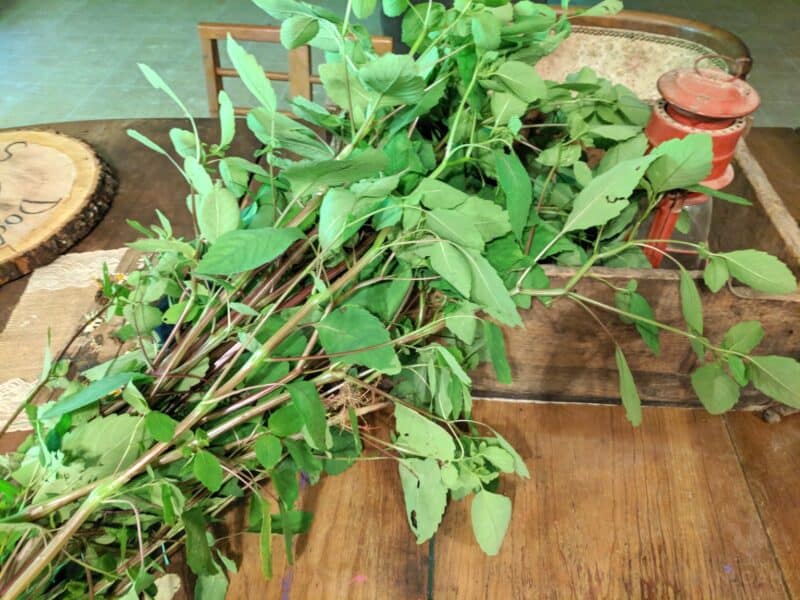
Table of Contents:
What Is Jewelweed?
Jewelweed (Impatiens capensis) has been used in natural healing remedies to also help treat joint pain, swelling, as an antidote to fish poisoniWhng, to increase blood flow, for pain post childbirth, and to soothe bruises.
There are two different varieties of the jewelweed plant. One type is commonly referred to as “whistle weed” or “garden balsam” and the other has often been dubbed “touch me not.”
The jewelweed plant is believed to have gotten its highly descriptive name from the shimmery appearance the leaves project if they are covered in raindrops or submerged in water.
This wild plant is prone to attracting beads of rain or dew onto the leaves for extended periods of time, causing the moisture to sparkle brightly in the sunshine.
Some folks have contended that the jewel type formation of the bright yellow or orange flowers also played a role in how the jewelweed plant got its name.
The jewelweed seed pods “pop” when they are touched. Many little country girls have grown up calling this healing plant the “popper flower” because of the fun they have had invoking the little “popping” seeds.
They did this by holding onto the stems of the flowers and causing the seeds to make a fun noise as they flew everywhere – some taking root and sparking more jewelweed plants to grow.
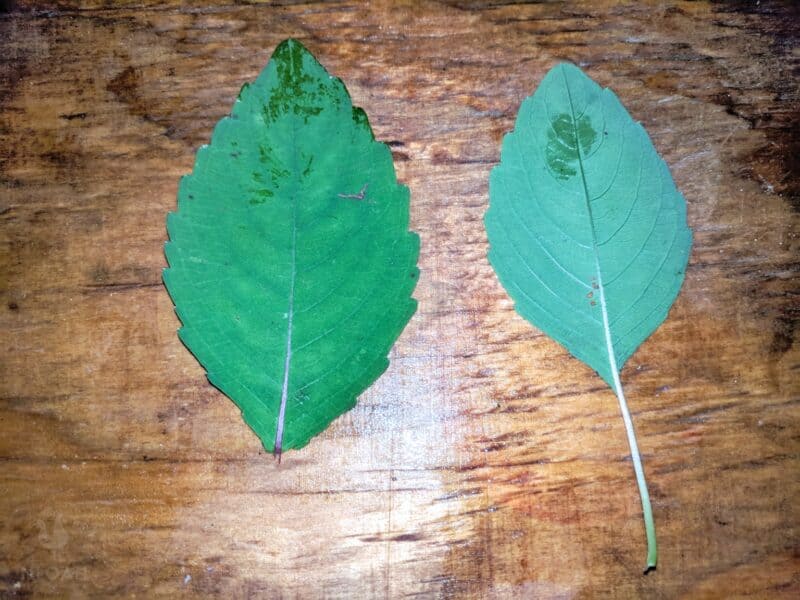
This popping action was likely why this popular variety of jewelweed was dubbed the “touch me not” plant by folks who were not interested in seeing this hardy plant grow in great abundance in their yard.
The “whistle weed” nickname refers to the small natural whistles you can make by poking a couple of holes into a hollow jewelweed stem, and blowing through them.
Jewelweed is a substantial attractor of pollinators, especially butterflies and honeybees…
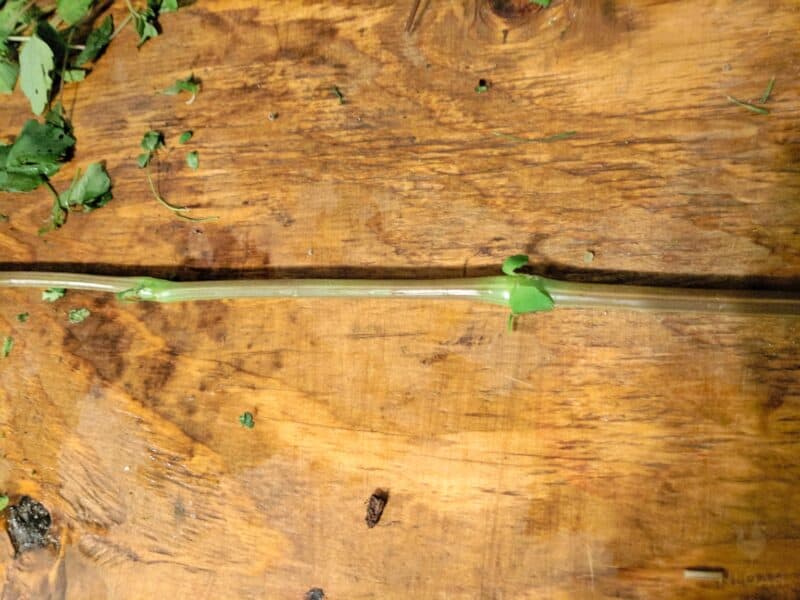
History
Native American tribes, especially those in Appalachia, frequently used the jewelweed plant to treat poison ivy and similar rashes.
The Southern Cherokee, Potawatomi, Chippewa, Meskwaki, and Omaha Native American tribes also used this wild and wonderful plant to deal with the stinging caused by both insects and stinging nettles, as well as bites by common insects like mosquitoes.
Seeds from the jewelweed plant were crushed after being roasted and used to treat post-labor blood flow issues as well as general childbirth pain and swelling – and sometimes even as an aid during menstruation to curtail intense blood flow.
Native Americans also used jewelweed to treat ringworm, as a digestive aid, and as a diuretic, as well.
The jewelweed plant was equally popular for centuries in Asia. As an ingredient in Chinese herbal medicines, jewelweed was used as a topical natural medicine to reduce both swelling and joint pain, as well as rheumatism.
The Japanese harvested the juice from the stem and flowers to treat minor burns and to both reduce and soothe itchy skin caused by rashes.
How to Find and Identify Jewelweed
Finding enough jewelweed to use when making these wonderful washes, tinctures, salves, and other recipes should not be difficult if you live in a rural area in most regions around the United States or in many parts of North America.
Jewelweed is commonly found in growing wild in greatest abundance in the Midwest, eastern and northern regions of the United States. It is not unusual to find jewelweed growing along the shady banks of creeks and lakes.
Jewelweed grows wildly in USDA Agricultural Growing Zones 2 through 11. The plant thrives in wet or moist soil. Most often both varieties of jewelweed plants grow along the wedge of the wood in partial shade to lightly sunny areas.
Jewelweed with yellow flowers may be a little bit more sun seeking than the orange flowering variety. It is not uncommon to see this beautiful weed nestled among many others along the sides of the road.
Never forage jewelweed (or any other plant) from areas where it is illegal to do so or from any location that you are not 100% sure is free from chemical pesticides, insecticides, or other similar types of spraying.
Jewelweed does not have any dangerous look alike plants, making it a perfect beneficial weed for novice foragers to find. The leaves on the plants are oval in shape and toothed. During the spring new sprouts from this self-seeding weed begin to appear.
Flower blossoms start to materialize in June and the plant usually reaches maturity by the final days of August. Even though the flowers will disappear before fall sets in, the leaves and stems on the plant will continue to be ready for harvest until the first hard frost kills it.
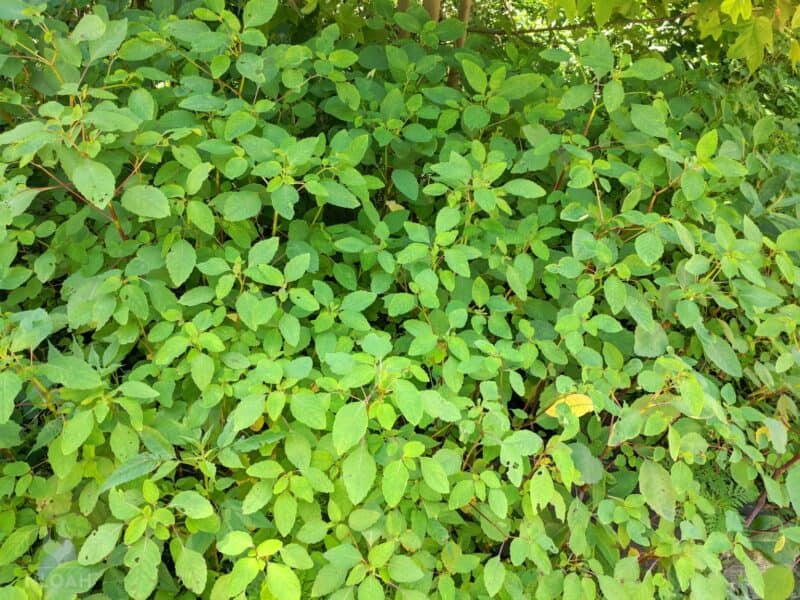
Ingestion
After being cooked, all of the above ground parts of the jewelweed plant can typically be consumed. The heating process is essential to the removal of natural, but possibly harmful compounds housed inside the plant.
Roasted jewelweed seeds boast a taste that is akin to that of walnuts. Eating small amounts of the seeds is usually considered safe for most people, but tossing them back in large quantities is not recommended – unless perhaps seeking a natural treatment for constipation.
Jewelweed seeds have been known to cause rapid and severe diarrhea in individuals who have had a history of kidney stones.
Individuals with this type of health history may want to avoid ingesting any type of jewelweed home remedy because even after being heated during the cooking process, the percentage of oxalates in the plant remains high
The vibrantly colored yellow or orange flowers of the jewelweed plant are also edible. If eating the leaves uncooked, it is best to harvest them during the early spring while they are still young.
Before using the leaves in a salad, boil them for 10 minutes, dump the water, and then refill the cook pot with fresh water and boil for another 10 minutes.
Jewelweed leaves are a common natural stir fry ingredient, and a superb way to garner the potent and potentially anti-fungal nutrients the plant possesses.
Both the stems and the leaves of jewelweed plants house lawsone – a natural compound that boast both anti-fungal and anti-inflammatory properties.
Lawsone may help reduce the irritation caused by poison ivy, stinging nettles rash, dermatitis, and insect bites. Lawsone is also a hennotannic acid.
The orange to red dye which can be extracted from the leaves has traditionally been used as a henna natural coloring agent for both hair and skin.
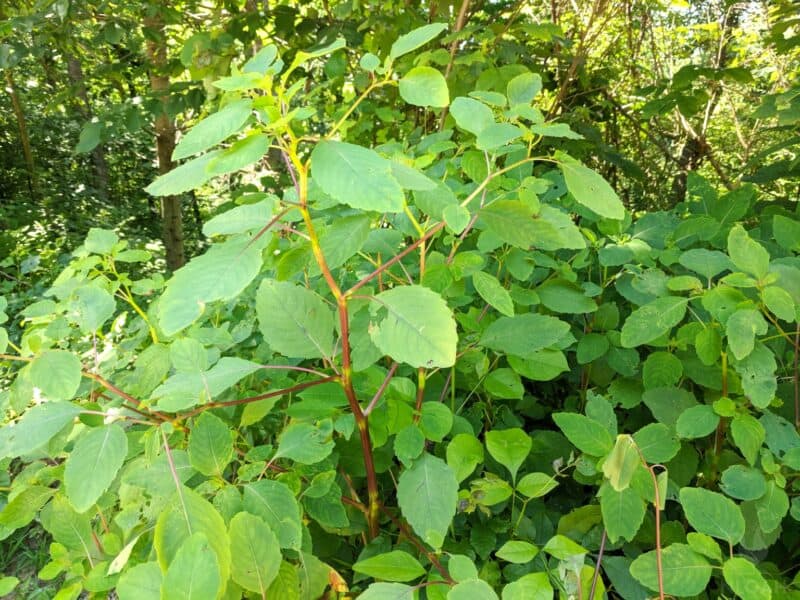
Uses
Parts of this wild plant have been used for centuries to treat a plethora of common skin problems:
| Poison Ivy | Minor Burns |
| Swollen Bruises | Stinging Nettles Rash |
| Poison Oak | Insect Sting |
| Insect Bite | Dermatitis |
| Athlete’s Foot | Poison Sumac |
| Joint Pain | Fish Poisoning |
| Mild to Moderate Swelling Around Topical Injury |
How to Use Jewelweed Topically
Jewelweed can be used both alone after being picked fresh from the plant, or as an ingredient in a poultice, or salve – either from a fresh or dried state.
I have found no better way to quickly deal with an insect sting or bite than simply picking a jewelweed leaf, crunching it between my fingers, applying a bit of saliva to it, and then patting it onto the problem area.
A wonderful feeling of relief begins nearly instantly after applying jewelweed crush leaf of stem “juice” onto a sting, bite, or poison ivy type rash – in my personal experience and in that of my family.
You may not always find yourself near a jewelweed bush after an injury, so harvesting the plant parts and dehydrating them or making an herbal infusion are excellent ways to preserve and stockpile this natural healing “weed.”
While it is the orange type of flowering jewelweed that grows most prevalently on our homestead, I have had similar success using the plant parts of yellow flowering jewelweed as well.
Because the plant has a fairly shallow taproot system, you can often pull up an entire plant from the ground with your bare hands to harvest the leaves and stems to quickly preserve it.
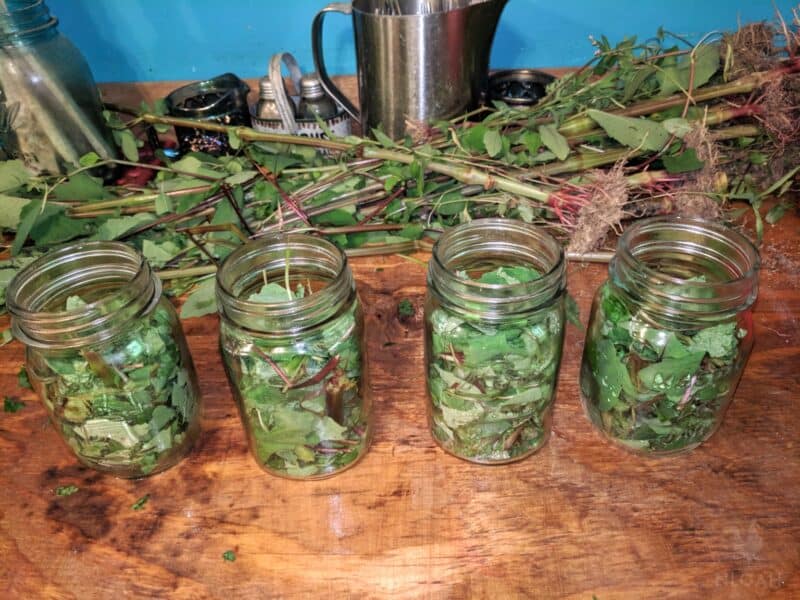
Harvesting
The prime time to harvest jewelweed is when it is in flowering mode. You can pull out the entire plant and then chop or snip the parts you intend to use or preserve but pulling it straight up out of the ground or snipping the stem just above the taproot at ground level.
If you only need just a little bit of jewelweed to treat an insect sting or similar issue or simply do not want to harvest too much if the plant at once so it continues to flourish, you can easily either snip or pluck just a few leaves or bit of stem and leaves to use on the go or in a small batch of natural remedies.
The best times of the year to harvest jewelweed is during the spring and summer. This is the time when the juice inside both parts of the plant are most plentiful. \
During the final weeks of summer and into the falls, the stems start to become hardened and turn “knobby.”
While I still readily use jewelweed as the juice begins to fade, you will likely need to garner more plant parts to gather all that you need or risk losing potency in the remedy that you are making.
The time of the year will also dictate the color of the salves, or tinctures that you make. The light to dark shades of reddish brown that will materialize do not relay any indication of potency decrease or increase.
Preservation
Jewelweed can be dehydrated in the sun, in a dehydrating machine, in the oven, and in an air fryer oven. All parts of the plant can be dehydrated – some take more than others to thoroughly dry.
The key to successful dehydration is to cut, tear, or chunk all pieces as uniformly as possible to ensure even and well-timed drying.
Make sure to place all parts that are being dried onto the dehydrator tray, screen, or rack so that they don’t touch to allow for adequate air flow in between each piece.
The dehydrated jewelweed parts can be run through a food processor or blender to essentially powder them to make them both easier to measure and to take up less storage space.
When properly dried and stored in an airtight container like a Mason jar or vacuum sealed bag in a cool, dry, dark place, dehydrated jewelweed can keep for a minimum of five years – in my personal experience.
Jewelweed Poison Ivy Rash Tincture
Equipment
- Quart Mason jar, lids, and rings
- Fine mesh strainer or cheesecloth
Ingredients
- Chopped jewelweed leaves, stems, or even flowers
- 80 proof Vodka or 91% or above rubbing alcohol
- a few pinches of any or all of the following: broad leaf plantain, chickweed, comfrey, or yarrow Optional but recommended
Instructions
- Put the jewelweed parts in the Mason jar so it is halfway to three quarters full.
- Add in the leaves or stems of any of the optional plants that you have also chosen to use.
- Cover the natural material with the vodka or the rubbing alcohol. Use only enough to cover the plant parts thoroughly. Leave a quarter of an inch headspace in the Mason jar.
- Seal the Mason jar with a lid and ring firmly.
- Place the jar in a warm and sunny place for a minimum of 21 days.
- Shake the jar thoroughly up to three times per day, each day.
- Open the jar and strain away the plant parts through a fine mesh strainer or cheesecloth – keeping the liquid.
Preserve the jewelweed poison ivy tincture in a clean Mason jar with a firm fitting lid in a cool dark place until needed to use as a wash on rash or to soak a poultice in to treat a poison ivy, poison sumac, or poison oak rash.
This solution has also been used successfully to treat minor burns – in my personal experience.
If you are fortunate enough to have large patches of wild jewelweed growing on your homestead or have cultivated it in massive quantities, taking a jewelweed soak might be possible.
Because poison ivy spreads so quickly, soaking in a tub of jewelweed may offer almost instant relief a rash that appears on multiple parts of the body.
Fill the tub with nice warm water and then stir in a jar (or more) of jewelweed tincture and ideally, sprinkle some crushed jewelweed leaves and stems into the bath, as well.
If you do not have any tincture on hand, using just the leaves and stems in large amounts may also offer a good measure of relief from the itching. Soak in the tub until the water turns too cool to be comfortable and repeat daily, if necessary.
The tincture recipe above can be used to treat poison ivy and the other noted conditions, or it can be enhanced even further to bolster its healing potency by adding additional ingredients.
Jewelweed Poison Ivy Wash Recipe
Equipment
- Jewelweed Tincture
- 1 Pint Mason Jar
Ingredients
- Water well water or distilled is highly recommended
- 5 drops tea tree essential oil
- 5 drops clove oil
- 5 drops lavender essential oil
Instructions
- Pour the jewelweed poison ivy tincture into the empty pint Mason jar to fill it almost half way full.
- Pour in enough water to fill the pint jar nearly full.
- Shake in the drops of recommended essential oils.
- Place a firm fitting lid and ring on the Mason jar, and store it in a cool dry place.
The jewelweed poison ivy solution should remain potent for approximately 4 to 5 months. To use, pour onto a cotton pad, gauze pad, or clean poultice material, and apply to the rash or minor burn area.
Jewelweed Bug Spray Recipe
Ingredients
- powdered or crushed jewelweed
- vodka, witch hazel, or rubbing alcohol
- spray bottle
Instructions
- Combine jewelweed parts to the rubbing alcohol, vodka, or witch hazel at a one to two ratio inside the spray bottle.
- Place the nozzle on the spray bottle and shake vigorously for roughly 60 seconds.
You can squirt this spray on people or livestock to help prevent insect bites and stings as a preventative and also to soothe stings and bites after they occur.
While this spray is designed to thwart or soothe insect stings and sprays, it can also offer itching and swelling relief from exposure to poison ivy, poison sumac, or to a slightly lesser degree poison oak.
Jewelweed Poultice Recipe
Ingredients
- Jewelweed
- Clean cloth or gauze pads and medical tape.
Instructions
- Crunch up some jewelweed leaves with your hand, and add a little saliva to them.
- Place the crushed and dampened jewelweed onto the poultice material, or lightly dampen the material with jewelweed wound wash.
- Secure the poultice into place by tying or taping it around the injured area using medical tape.
- Repeat this step with clean poultice material as needed. Never repeat these steps with a used poultice.
When using a jewelweed poultice, the dressing will need to be changed a minimum of two times per day.
The natural treatment may need to be repeated for several days to bring relief to swollen and sore bruises, joints, and minor burns.
Jewelweed Infused Herbal Soap Recipe
Equipment
- soap molds
- 2 bowls
- Fine mesh strainer or cheesecloth
- wax paper or dish towel
Ingredients
- soap base or your favorite DIY natural homemade soap recipe
- 2 pinches to 1 cup powdered jewelweed
- 1 cup chopped dried or fresh plantain
- 3 drops lavender essential oil
- 8 ounces coconut oil if the soap base does not include or call for a specific amount of the carrier oil
Instructions
- Place the powdered jewelweed and plantain in a bowl and combine them by stirring in only enough lukewarm water to mix them together thoroughly.
- Cover the bowl loosely with wax paper or a clean dish towel, and place it in the refrigerator to settle and chill overnight.
- Strain away the plant matter and keep the greenish brown juice in a clean bowl.
- Add in all of the other soap ingredients, and stir to combine thoroughly.
- Mix in the soap base and process by following the ingredients on the package.
The soap can be used to treat a minor wound, minor burn, skin rash, or insect stings and bites or merely on a daily basis to soothe the skin and attempt to avoid dry skin or dermatitis flare-ups.
Jewelweed and Vinegar Infusion Recipe
Equipment
- 2 quart Mason jars
- rings
- lids
- Spoon
- Fine mesh strainer or cheesecloth
Ingredients
- Apple Cider Vinegar
- 1 cup jewelweed stems, leaves, and flowers
Instructions
- Chop the jewelweed plant parts finely if using fresh material or crunch – powder dried matter.
- Place the jewelweed in the Mason jar just lightly packing it, until the jar is three quarters of the way full.
- Pour in only enough apple cider vinegar to cover the plant parts.
- Stir all of the ingredients together to combine thoroughly.
- Firmly seal the Mason jar using the lid and ring.
- Shake the jar vigorously for at least 30 seconds.
- Place the jar in a cool dry place out of direct sunlight for roughly four weeks – the jar does not have to be shaken during the settling process.
- Strain the mixture into a clean Mason jar, keeping the liquid and discarding the plant parts.
- Seal the Mason jar with a lid and ring firmly and store it into a cool, dry place.
A jewelweed infused vinegar can be used to alleviate soreness in bruises, inflammation, minor burns, minor skin rashes, as well as insect stings and bites.
To use, dampen a cotton ball with the jewelweed and vinegar solution and dab it onto the affected area.
Carefully pour the vinegar onto the cotton balls to ensure the material does not fall into the jar and contaminate the contents.
When stored properly and not exposed to moisture (when opening any longer than absolutely necessary), the jewelweed and apple cider vinegar infusion can remain potent for about one year – in my personal experience.
I recommend storing the solution in as small of a jar as possible to avoid the need to open a large bottle repeatedly over time.
Jewelweed Salve Recipe
Equipment
- 2 quart Mason jars (additional small jars with a firm fitting lid will be needed to store the salve)
- Quart Mason jar lid, and ring
- Cookpot or double boiler
- Cheesecloth or fine mesh strainer
Ingredients
- 1 cup jewelweed crushed or powdered
- ½ cup carrier oil coconut, olive, or almond are my personal favorites
- 1 tablespoon shea butter or coconut butter or a mixture of both
- 2 tablespoons beeswax pellets or pastilles
- ½ cup vitamin E
- water
- 5 pinches chopped broadleaf plantain optional but highly recommended
- 10 drops essential oils for scent optional
Instructions
Directions
- The jewelweed (and plantain, if using), have to be steeped in your chosen carrier oil for a minimum of two hours. It is vital not to introduce plant matter directly into the salve because it will cause it to go rancid rather quickly, prevent proper curing, and can cause contaminants to be filtered into the recipe mixture.
- Fill the Mason jar one half to three quarters of the way full with the jewelweed and plantain pieces.
- Fill up the rest of the space in the Mason jar with the carrier oil. Expect to use roughly three ounces of the oil during the steeping process.
- Put a medium to large cook pot on the stove, and fill it just a few inches deep with water – or use a double boiler.
- Turn the heat under the pot to low – only.
- Place the Mason jar of plant parts into the cook pot.
- Steep the jewelweed salve base for approximately two hours over low heat only. If the Mason jar glass becomes too warm to comfortably touch during the steeping process, turn down the heat.
- Adding more carrier oil into the Mason jar to ensure the jewelweed and plantain parts remain covered during the steeping process might be necessary.
- Strain the salve base mixture through a fine mesh strainer or cheesecloth – discarding the plant parts but keeping the liquid – which should be a shade of greenish orange.
Salve Directions
- Put the unused Mason jar in the cook pot with the several inches of water – add more water if necessary.
- Pour the beeswax, shea butter or coconut butter, and carrier oil into the Mason jar.
- Turn the stove burner under the pot on low heat again.
- Stir the mixture as constantly as possible to ensure the ingredients do not get scorched while waiting for the beeswax to melt. This process can easily take five minutes. Using beeswax pastilles instead of the larger pellet form of the wax or grating small thin bits from a wax brick can help speed up the melting process. The beeswax melting point is 170 degrees F (77 C).
- Once the beeswax has melted and is thoroughly combined with the other ingredients, turn off the heat and carefully remove the Mason jar from inside of the pot and the stove.
- Add in the liquid you made from steeping the jewelweed and plantain, and stir thoroughly to combine.
- Stir in the drops of essential oils and the vitamin E.
- Pour the solution into the small storage jars and allow it to cool and harden completely overnight before using or storing.
This salve can be used to alleviate discomfort, minor burns, swelling, and rashes just as the infusions, washes, and poultice recipes noted above.
Another recipe you may want to try is this one containing jewelweed, plantain, and beeswax.
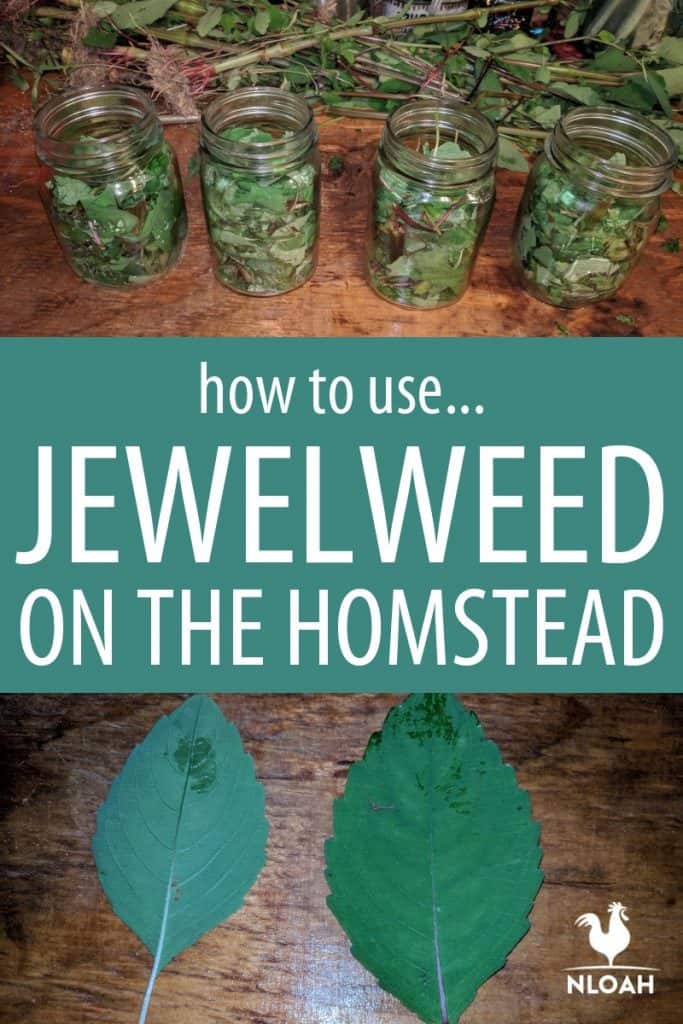

Tara lives on a 56 acres farm in the Appalachian Mountains, where she faces homesteading and farming challenges every single day, raising chickens, goats, horses, and tons of vegetables. She’s an expert in all sorts of homesteading skills such as hide tanning, doll making, tree tapping, and many more.

Thank you so much for all this information!! It grows abundantly on my farm and this is the year I plan on harvesting it!
Hi! Wondering if the plant can be frozen after harvesting and then used in the recipes later?
Thank you!
Hi Susan! I ave successfully frozen jewelweed in season and used the same as fresh during the winter. I place as many leaves as I can into a ziplock bag, forcing all of the air out and sealing it. Be sure to label it as it can turn dark when it thaws out, I have also preserved it in glycerin. It does turn brown, but the quality is close to that of fresh.
Excellent Jewelweed writeup and covering most all areas I had questions on plus not just one recipe, but recipes for Tincture/Regular Wash/Wound Wash/Bug Spray/Poultice/Soap/Infusion/Salve. Just fantastic.
The question I have is I just completed my very first tincture(alcohol based) and it’s Jewelweed due to much poison ivy here. Now that I have the tincture, I want to make a salve from it as well. Your salve recipe doesn’t comment on how to start from tincture… Nor does it say how much liquid is left over and being used from steeping fresh plants.
So can you advise me on how much liquid jewelweed tincture I should use for your salve recipe above?
Thank you and much appreciated.